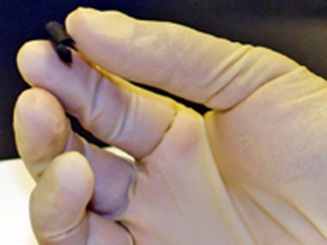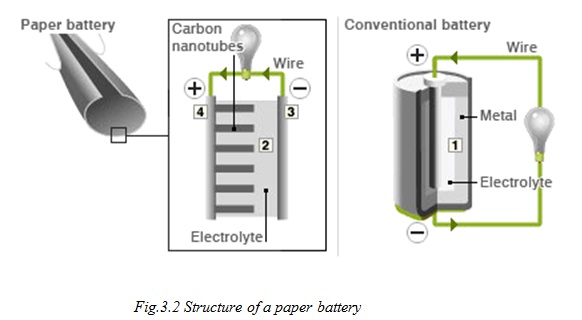Inception of Knowledge Era is about to provide knowledge regrading latest technologies,fun,facts,amazing facts,latest concepts,about gadgets,cars and bikes.
Wednesday, April 9, 2014
Tuesday, April 1, 2014
Paper Battery
Definition
A paper battery is a flexible, ultra-thin energy storage and production device formed by combining carbon nanotube s with a conventional sheet of cellulose-based paper. A paper battery acts as both a high-energy battery and supercapacitor , combining two components that are separate in traditional electronics . This combination allows the battery to provide both long-term, steady power production and bursts of energy. Non-toxic, flexible paper batteries have the potential to power the next generation of electronics, medical devices and hybrid vehicles, allowing for radical new designs and medical technologies.
Paper batteries may be folded, cut or otherwise shaped for different applications without any loss of integrity or efficiency . Cutting one in half halves its energy production. Stacking them multiplies power output. Early prototypes of the device are able to produce 2.5 volt s of electricity from a sample the size of a postage stamp
Paper battery offers future power
They have produced a sample slightly larger than a postage stamp that can store enough energy to illuminate a small light bulb. But the ambition is to produce reams of paper that could one day power a car.
Professor Robert Linhardt, of the Rensselaer Polytechnic Institute, said the paper battery was a glimpse into the future of power storage. The team behind the versatile paper, which stores energy like a conventional battery, says it can also double as a capacitor capable of releasing sudden energy bursts for high-power applications.

How a paper battery works
While a conventional battery contains a number of separate components, the paper battery integrates all of the battery components in a single structure, making it more energy efficient.
Integrated devices
The research appears in the Proceedings of the National Academy of Sciences (PNAS).
"Think of all the disadvantages of an old TV set with tubes," said Professor Linhardt, from the New York-based institute, who co-authored a report into the technology.
"The warm up time, power loss, component malfunction; you don't get those problems with integrated devices. When you transfer power from one component to another you lose energy. But you lose less energy in an integrated device."
The battery contains carbon nanotubes, each about one millionth of a centimetre thick, which act as an electrode. The nanotubes are embedded in a sheet of paper soaked in ionic liquid electrolytes, which conduct the electricity. The flexible battery can function even if it is rolled up, folded or cut. Although the power output is currently modest, Professor Linhardt said that increasing the output should be easy.
Construction and Structure
Construction
A very brief explanation has been provided.
• Cathode: Carbon Nanotube (CNT)
• Anode: Lithium metal (Li+)
• Electrolyte: All electrolytes (incl. bio electrolytes like blood, sweat and urine)
• Separator: Paper (Cellulose)

The process of construction can be understood in the following steps:
• Firstly, a common Xerox paper of desired shape and size is taken.
• Next, by conformal coating using a simple Mayer rod method, the specially formulated ink with suitable substrates (known as CNT ink) is spread over the paper sample.
• The strong capillary force in paper enables high contacting surface area between the paper and nanotubes after the solvent is absorbed and dried out in an oven.
• A thin lithium film is laminated over the exposed cellulose surface which completes our paper battery. This paper battery is then connected to the aluminum current collectors which connect it to the external load.
• The working of a paper battery is similar to an electrochemical battery except with the constructional differences.
The paper battery is designed to use a paper-thin sheet of cellulose (which is the major constituent of regular paper, among other things) infused with aligned carbon nanotubes. The nanotubes act as electrodes, allowing the storage devices to conduct electricity. The battery will currently provide a low, steady power output, as well as a supercapacitor’s quick burst of energy. While a conventional battery contains a number of separate components, the paper battery integrates all of the battery components in a single structure, making it more energy efficient and lighter.
Subscribe to:
Posts (Atom)
.jpg)
